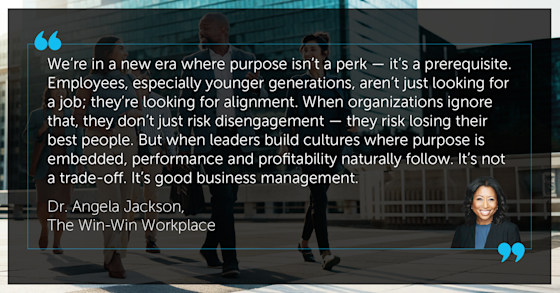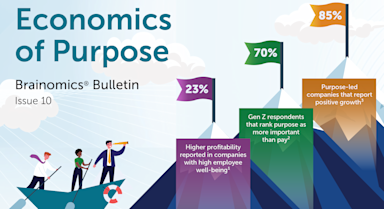Economics of Purpose
Brainomics Issue 10Open Printable PDFOnly one-third of the U.S. workforce reports being actively engaged in their work,4 which is a human tragedy since our jobs occupy such a major part of our lives. The Brainomics® team is privileged to work in a mission-driven environment, as research shows a direct link between purpose and engagement. However, we take this link one step further, asserting that when we prioritize purpose, profit follows naturally.Let’s first establish a common understanding: purpose is how we engage with the world, directing our actions and behaviors. More than a personal motivator, it’s an intention to achieve meaningful long-term goals that leave a positive mark on the world beyond ourselves. Research establishing a holistic measure of the brain’s health, the BrainHealth Index, reveals the unique role of purpose as a contributing factor of brain health.5 Being guided by a broader intention enhances our capacity to overcome challenges and engage in fulfilling experiences. When work aligns with a deeper meaning (i.e., purpose), we experience greater motivation, agency and satisfaction – all of which support stronger brain health. Neuroscience shows that feeling connected to a meaningful goal activates brain regions linked with motivation and reward.6 Engaging in activities that further this goal releases dopamine in your brain – a feel-good neurotransmitter that rewards and strengthens goal-directed behaviors.
Research shows that people with a strong sense of purpose
- Experience lower stress and better sleep7
- Demonstrate enhanced cognitive function and resilience7;8
- Have stronger immune systems8
- May have reduced risk of dementia8
People want to spend their time in meaningful ways
70% of employees say their personal sense of purpose is defined by their work.9 Companies often describe themselves as "mission driven" when they're anchored by values and goals that extend beyond profit.Employee alignment in purpose yields measurable impact
- The 100 Best Companies to Work for in America, where employees report high levels of trust and value alignment, earned 2.1% more annually, compared to industry benchmarks.1
- Mission-driven companies see 30% higher levels of innovation and 40% higher levels of retention.11
- Employees at mission-driven companies outperform in every indicator.3
As a corporate leader, what can you do to invest in purpose?
- Clearly define and incorporate a shared vision across your organization. Purpose is the company’s reason for existing beyond profit, so take steps to ensure each employee understands how their role contributes to this overarching mission, providing opportunities for shared reflection, connection and input.9
- Build a culture that supports purpose. Cultivate a work environment where employees see the positive impact of their work, driven by a shared goals and empowered by autonomy, influence, personal growth and strong relationships.3
- Start with purpose-aligned recruitment. Integrate values and commitments into branding and recruitment practices to attract and hire candidates who already connect with your organization's goals. During onboarding, communicate how the position contributes to the broader mission and then take time to recognize and reward their purpose-driven contributions on a regular basis.
- Measure outcomes. Reinforce this approach by tracking how steps to build a positive, purpose-driven work culture impact employee productivity, morale and retention, as well as the company’s bottom line.







